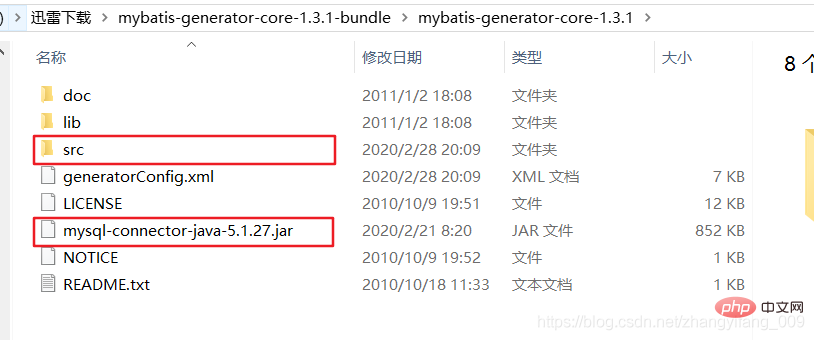

Free learning recommendation: mysql tutorial(Video)
1. Introduction to MyBatis reverse engineering
During the development process, there are often situations where MyBatis needs to be used. Under normal circumstances, MyBatis construction projects cannot avoid writing entity classes, Dao interfaces, and Mapper mappings. files, these tasks are similar, have a certain degree of repetition, and are sometimes error-prone, so someone invented [MyBatis Reverse Engineering]->MyBatis Generator. MyBatis Generator (MBG) is a code generator that can generate the dao.java, mapper.xml, and pojo entity class files we need. For some projects with many tables, it can reduce a lot of workload and improve our s efficiency. There are many similar tutorials on the Internet. You can install plug-ins in eclipse to generate, and generate in IDEA. Since I use the command line to implement it, I will only introduce the command line method here, which is relatively simple.
The SQL statements that can be generated include:
The variations of these statements depend on the structure of the table (for example, if the table does not have a primary key, MBG will not generate updates through the primary key function) More introductions can Reference documentation: http://mybatis.org/generator.
2. Download the MyBatis Generator file
I downloaded it from github, GitHub address: https://github.com/mybatis /generator/releases, it is recommended to use Thunder to download which should be faster. Download the file and decompress it. The decompressed file directory is as follows: 
Check the contents of the lib folder after decompression. This is the jar package we need to use
3. Configure the generatorConfig.xml file
Create a new generatorConfig.xml file in the folder you just decompressed. Of course, the name of this file is I took it myself, so what does this file do? This configuration file tells MBG:
In addition, we still need to do some preparations:
1) Find the location of the jar package of your database driver. For the convenience of demonstration, I put the database driver under the directory where I just unzipped it. Mine is MySQL5 .7
2) Create a new empty src folder to store the generated files 
generatorConfig.xmlThe content of the file is as follows: 
generatorConfig.xml code
PUBLIC "-//mybatis.org//DTD MyBatis Generator Configuration 1.0//EN" "http://mybatis.org/dtd/mybatis-generator-config_1_0.dtd"><generatorconfiguration><!--数据库驱动,最好不要有中文字符,不然会找不到--><classpathentry></classpathentry><context><commentgenerator><property></property><property></property></commentgenerator><!--数据库链接地址账号密码--><jdbcconnection></jdbcconnection><javatyperesolver> <property></property></javatyperesolver><!--生成Model类存放位置--><javamodelgenerator> <property></property> <property></property></javamodelgenerator><!--生成映射文件存放位置--><sqlmapgenerator> <property></property></sqlmapgenerator><!--生成DaoMapper类存放位置--><javaclientgenerator><property></property></javaclientgenerator><!--生成对应表及类名,需要记住的一点是逆向工程无法生成关联关系,只能生成单表操作--><table enablecountbyexample="false" enableselectbyexample="false"></table></context></generatorconfiguration>
The information that needs to be configured, I have circled it with a red box here, the information that needs to be configured includes
database information;
generated The package name of the entity class and targetProject are the location where our generated file will be stored. I put it in the src directory;
Generate mapper interface information;
Generated mapper xml File information, here my mapper interface and xml file are in the same directory
The database table configuration information to be generated, which tables need to be generated, just add it at the end. The specific meaning of the configuration attributes in the table can be viewed in the document For instructions, refer to here
4. Generate code
The commands that need to be executed on the command line are as follows:
java -jar lib/mybatis-generator-core-1.3.1.jar -configfile generatorConfig.xml -overwrite
We can cd to the current directory and then execute the above command. Here I put it into the bat file to execute, create a new start.bat file, and copy the above command
Double-click to execute the bat file, you can see the generated file in the src directory, and then copy the file we generated to our project to use it!
ps: In the generated file, some fields or methods may not be created correctly. It should be due to the inconsistency between the MySQL environment and the plug-in version. You can try adding the following attributes to jdbcConnection: <property name="databaseSchemaUpdate" value="true"></property>
More related learning recommendations: mysql learning
The above is the detailed content of Let's take a look at the MyBatis command line implementation of reverse engineering. For more information, please follow other related articles on the PHP Chinese website!
 mybatis first level cache and second level cache
mybatis first level cache and second level cache
 What is the difference between ibatis and mybatis
What is the difference between ibatis and mybatis
 How to configure database connection in mybatis
How to configure database connection in mybatis
 What is the working principle and process of mybatis
What is the working principle and process of mybatis
 What are the differences between hibernate and mybatis
What are the differences between hibernate and mybatis
 Is Bitcoin legal in China?
Is Bitcoin legal in China?
 The difference between rom and ram
The difference between rom and ram
 Usage of RAC in Oracle
Usage of RAC in Oracle